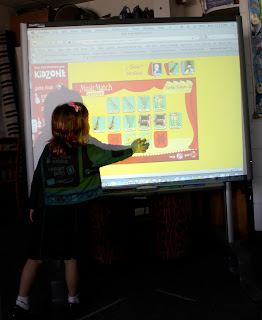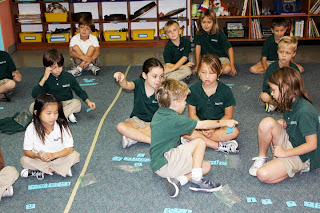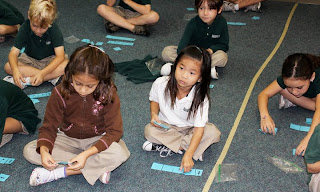Thank you to all the parents who offered me to opportunity to present to you on Thursday. I love sharing what your children experience in music class. In my talk I shared three areas of the music curriculum with grade level representatives: Orff instruction, music listening, and playing the recorder. There was one other area of study that I only touched on, and that is the importance of technology in my teaching. Yes, I subscribe to 256 blogs! But technology integration in the music classroom involves so much more to me.
For quite a while now I have been interested in the meaningful use of technology in the music classroom. I am quite a fundamentalist, and I believe that the Arts should be taught it their purest form. However, more that anything, I want your children to leave my classroom knowing that I have given them the opportunity to learn music in many different ways. I believe that technology has a place in the music classroom and can excite the music spark in your children that is already so bright.
Teacher modeling is still important in teaching, however today lessons are guided instruction by teachers rather than lecture and note taking sessions. We, as an educational whole, are moving away from teacher-centered learning and toward student-centered learning. Now, students can understand and manipulate media that open the door to learning. When students feel as if they have a hand in their own learning, their motivation and self-confidence increases.
Learning Styles from Valerie Díaz Leroy on Vimeo.
Technology helps to transform the classroom into a participatory culture. Whether in an online learning environment or by using media as a tool for self expression in the classroom, digital media enable students to open up and express their creativity, all while developing a stronger sense of self. All of our students go to keyboarding in the lab. One fourth grade student explained to me how learning to type has helped his writing. It is a lot easier to type out what he is thinking because his fingers (on the keyboard) can keep up with the thoughts he wants to write down. I can relate. I cannot write as fast as I can type. I often lose my thoughts because I cannot not express them on paper in hand-written form fast enough!
Creating from Valerie Díaz Leroy on Vimeo.
It's Faster from Valerie Díaz Leroy on Vimeo.
“Today’s children learn through play the skills they will apply to more serious tasks later.” (Jenkins, 10) Learning can be fun. Learning should be fun. In fact, rule number seven in the music room is “HAVE FUN!” Music games and other educational games give students the opportunity to learn in a way that is most natural to them. Digital games open the door for learning to continue at home, as many of these games are available “in the cloud” (online). Wednesday the kindergartners “traveled” to New York to learn about orchestral instruments from the
NY Philharmonic. Students had so much fun and many went home and played with their families!
Educational Games from Valerie Díaz Leroy on Vimeo.
Real world relevance is so important in teaching and learning. I want my students to understand how what they are studying in school relates to their life now, or will in the future.
Real World Skills from Valerie Díaz Leroy on Vimeo.
Digital media can help students answer questions through research and exploration. The immediacy and accuracy of information online allows learning to be spontaneous and instantaneous. Up-to-date information is at our fingertips, so let’s use it!
Up-to-date Information from Valerie Díaz Leroy on Vimeo.
Most important, I want my students, your children, to interact meaningfully, to collaborate, and to find value in their learning experiences. I will continue to teach the essence of music through song and dance, instrument playing, and rhythm games. I am embarking on journey to find digital media that will highlight the current music curriculum and help make it relevant in the 21st century.
REFERENCES
A Quantitative Synthesis of Recent Research on the Effects of Teaching and Learning with Technology on Student Outcomes (December, 2002) Connell, M. L., Gray, J., Waxman, H.
A Retrospective on Twenty Years of Education Technology Policy (October, 2003) Katie McMillan Culp, Margaret Honey, & Ellen Mandinach
Confronting the Challenges of Participatory Culture: Media Education for the 21st Century Jenkins, H.
The Impact of Education Technology of Student Achievement: What the Most Current Research Had to Say (1999) Schacter, J.













